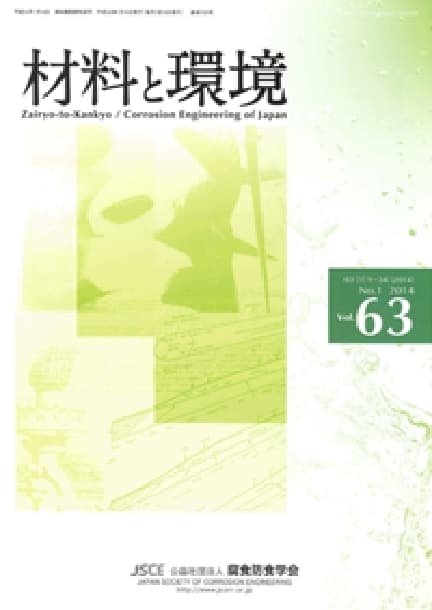- TOP
- Zairyo-to-Kankyo
- Vol. 61 (2012), No. 1
Zairyo-to-Kankyo Vol. 61 (2012), No. 1
Backnumber
-
Vol. 74 (2025)
-
Vol. 73 (2024)
-
Vol. 72 (2023)
-
Vol. 71 (2022)
-
Vol. 70 (2021)
-
Vol. 69 (2020)
-
Vol. 68 (2019)
-
Vol. 67 (2018)
-
Vol. 66 (2017)
-
Vol. 65 (2016)
-
Vol. 64 (2015)
-
Vol. 63 (2014)
-
Vol. 62 (2013)
-
Vol. 61 (2012)
-
Vol. 60 (2011)
-
Vol. 59 (2010)
-
Vol. 58 (2009)
-
Vol. 57 (2008)
-
Vol. 56 (2007)
-
Vol. 55 (2006)
-
Vol. 54 (2005)
-
Vol. 53 (2004)
-
Vol. 52 (2003)
-
Vol. 51 (2002)
-
Vol. 50 (2001)
-
Vol. 49 (2000)
-
Vol. 48 (1999)
-
Vol. 47 (1998)
-
Vol. 46 (1997)
-
Vol. 45 (1996)
-
Vol. 44 (1995)
-
Vol. 43 (1994)
-
Vol. 42 (1993)
-
Vol. 41 (1992)
-
Vol. 40 (1991)
Keyword Ranking
15 Dec. (Last 30 Days)
Zairyo-to-Kankyo Vol. 61 (2012), No. 1
Effect of Applied Stress on the Initiation of Localized Corrosion for Sensitized 304 Stainless Steel in Aqueous MgCl2 Solutions
Eiji Tada, Satoshi Senba
pp. 14-21
DOI:
10.3323/jcorr.61.14Abstract
In this study, the effect of applied stress on the initiation of localized corrosion and morphology transition from pits to cracks for sensitized 304 stainless steel were investigated in aqueous MgCl2 solutions. Anodic polarization curves for pre-strained specimens and electrochemical noise responses such as open circuit potential and galvanic current between stressed and unstressed specimens were measured. Anodic polarization curves for sensitized 304 stainless steel revealed that initiation of pitting corrosion were enhanced on the pre-strained samples. From the results of the electrochemical noise responses, initiation of localized corrosion were promoted on the specimens to which the stress was applied in 2 M MgCl2 solution. The morphology transition from pits to cracks was observed when plastic strain was applied during the growth of pitting corrosion.
Effect of Creep on Susceptibility to Stress Corrosion Cracking of Zirconium in the Simulated Spent Nuclear Fuel Solution
Chiaki Kato, Yasuhiro Ishijima, Masahiro Yamamoto
pp. 22-28
DOI:
10.3323/jcorr.61.22Abstract
Susceptibility to stress corrosion cracking (SCC) of zirconium was investigated as for in the spent nuclear fuel dissolver environment of the reprocessing facilities. Constant load tensile tests were conducted in the nonradioactive simulated spent nuclear fuel solution in both nobler potential and boiling heat-transfer conditions. It was found that susceptibility to SCC of zirconium strongly depended on electrode potential. The time to failure clearly declined at 1.55 V (vs. SSE) and the cleavage fracture like a facet-shaped was observed. Quasi-cleavage fracture was only observed on the specimen surface less noble than 1.50 V, but the time to failure scarcely declined comparing to that of silicon oil. Decline of time to failure was also observed under boiling heat-transfer condition. However, the decline of time to failure under boiling heat-transfer condition was nearly equal to the corresponding temperature to heat-transfer condition with silicon oil. As for the index of susceptibility to SCC, the ratio of transition time from secondary to third creep to failure time indicated that the susceptibility to SCC were very high in 1.55 V. The index indicated that boiling heat-transfer scarcely enhanced the susceptibility. It's considered that SCC behavior of zirconium in spent nuclear fuel dissolver environment mainly depends on its creep property.
Article Access Ranking
15 Dec. (Last 30 Days)
-
Delayed Fracture Mechanism of 1700 MPa-Class Quenched and Tempered Bolt under Atmospheric Corrosion Environment
Tetsu-to-Hagané Advance Publication
-
Perspectives on the Promising Pathways to Zero Carbon Emissions in the Steel Industry toward 2050
ISIJ International Vol.65(2025), No.2
-
Effect of B on Surface Oxidation Behavior and Phosphatability of Si-Mn-added Cold-Rolled Steel Sheets
ISIJ International Advance Publication
-
Factors Influencing the Bonding Phase Structure of Iron Ore Sinters
ISIJ International Vol.43(2003), No.9
-
Effect of microstructural heterogeneity on fatigue limit of as-quenched low-carbon low-alloy martensitic steel
ISIJ International Advance Publication
-
Prussian blue as a fully reversible hydrogenochromic material for visualizing hydrogen distribution in Fe sheet
ISIJ International Advance Publication
-
Progress of Strip Casting Technology for Steel; Historical Developments
ISIJ International Vol.52(2012), No.12
-
Research Progress on Optimal Blending of Iron Ore Powders for Sintering
ISIJ International Vol.65(2025), No.12
-
-
Microstructures and Reduction Properties of High CaO Concentration Sintered Ore
ISIJ International Advance Publication
You can use this feature after you logged into the site.
Please click the button below.










